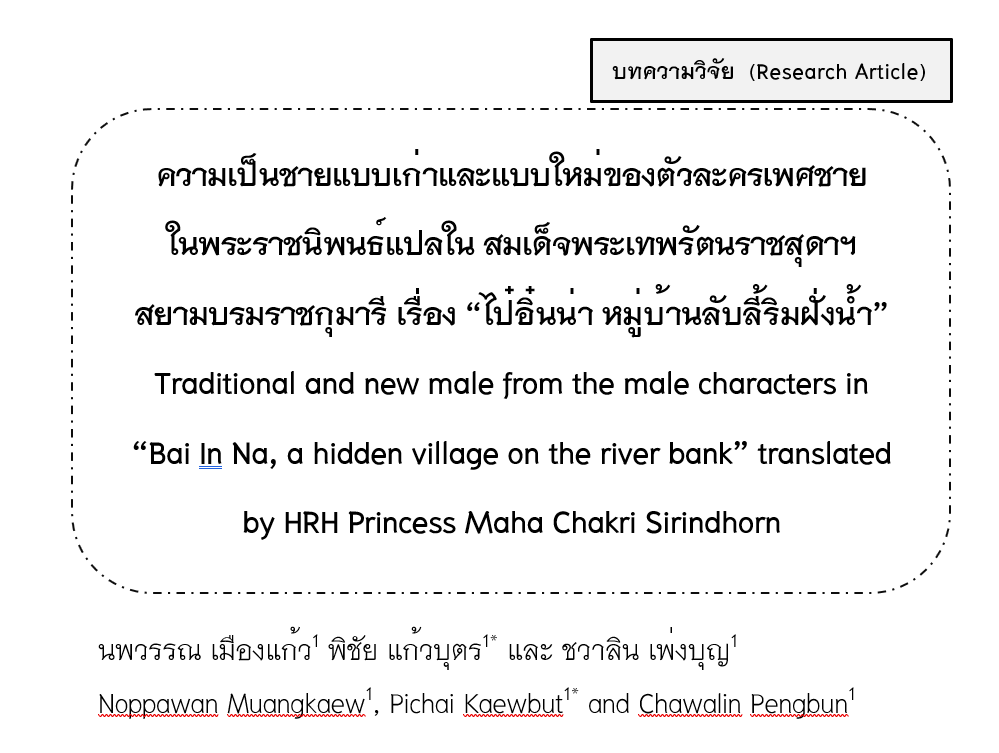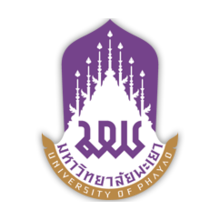Traditional and New Male from the Male Characters in “Bai In Na, a hidden Village on the River Bank” Translated by HRH Princess Maha Chakri Sirindhorn
Keywords:
Patriarchy, Traditional Male, New Male, Bai In NaAbstract
The purposes of this research are to study traditional and new male from the male characters in “Bai In Na, a hidden village on the river bank and compare masculinity of male characters in literature. The results show that there are both of traditional male and new male, full and blended masculinity. The characteristics of male characters are more subordinate to the traditional male from the traditional Chinese society than the new male. It reflects physical strength, aggression, violence and not emotionally sensitive or self-revealing. The new male expresses the concept of economic achievement, intelligence, interpersonal skills and emotionally sensitive and self-expressive with woman. Masculinity is determined by the social change. Today masculinity is more distinct and diverse than before. Although traditional male still has power and influence clearly nowadays, new male has also been accepted and presented simultaneously.
References
ชวาลิน เพ่งบุญ, นพวรรณ เมืองแก้ว, อธิปัตย์ นิตย์นราและพิชัย แก้วบุตร. (2563). สตรีนิยมผ่านตัวละครเพศหญิง: กรณีศึกษา “ไป๋อิ๋นน่า หมู่บ้านลับลี้ริมฝั่งน้ำ” พระราชนิพนธ์แปลในสมเด็จพระเทพรัตนราชสุดา ฯ สยามบรมราชกุมารี. วารสารมนุษยศาสตร์และสังคมศาสตร์ มหาวิทยาลัยพะเยา, 8(1), 180-204.
ณรงค์กรรณ รอดทรัพย์. (2555). ปิตาธิปไตย: ภาพสะท้อนแห่งความไม่เสมอภาคระหว่างชายหญิงในสังคมเอเชีย. วารสารวิชาการ มหาวิทยาลัยราชภัฏบุรีรัมย์, 4(2), 30-46.
ดิษยทรรศน์ ศรีบุญเรืองและ สุทธภา อินทรศิลป์. (2562). ภาพความเป็นชายจากการสร้างตัวละครเอกฝ่ายชายใน นวนิยายเรื่องบุพเพสันนิวาสของรอมแพง. วารสารบัณฑิตศึกษามหาจุฬาขอนแก่น, 6(1), 431-445.
ปรานี วงษ์เทศ. (2544). เพศและวัฒนธรรม. (พิมพ์ครั้งที่ 2). กรุงเทพฯ: เรือนแก้วการพิมพ์.
เยาวลักษณ์ เฉลิมเกียรติ. (2542). คำเรียกญาติในจังหวัดนครศรีธรรมราช. (ปริญญานิพนธ์การศึกษามหาบัณฑิต (การบริหารการศึกษา) สงขลา: บัณฑิตวิทยาลัย มหาวิทยาลัยทักษิณ.
ฉือจื่อเจี้ยน. (2561). ไป๋อิ๋นน่า หมู่บ้านลับลี้ริมฝั่งน้ำ [白银那] (เทพรัตนราชสุดาฯ สยามบรมราชกุมารี, สมเด็จพระ, ผู้แปล) (ต้นฉบับพิมพ์ ปี ค.ศ. 1994). กรุงเทพฯ: นานมีบุ๊คส์.
Abbott, M.R. (1992). Masculine & feminine. Boston: McGraw-Hill.

Downloads
Published
How to Cite
Issue
Section
License
Copyright (c) 2022 Phayao University

This work is licensed under a Creative Commons Attribution-NonCommercial-NoDerivatives 4.0 International License.
ผู้นิพนธ์ต้องรับผิดชอบข้อความในบทนิพนธ์ของตน มหาวิทยาลัยพะเยาไม่จำเป็นต้องเห็นด้วยกับบทความที่ตีพิมพ์เสมอไป ผู้สนใจสามารถคัดลอก และนำไปใช้ได้ แต่จะต้องขออนุมัติเจ้าของ และได้รับการอนุมัติเป็นลายลักษณ์อักษรก่อน พร้อมกับมีการอ้างอิงและกล่าวคำขอบคุณให้ถูกต้องด้วย
The authors are themselves responsible for their contents. Signed articles may not always reflect the opinion of University of Phayao. The articles can be reproduced and reprinted, provided that permission is given by the authors and acknowledgement must be given.







